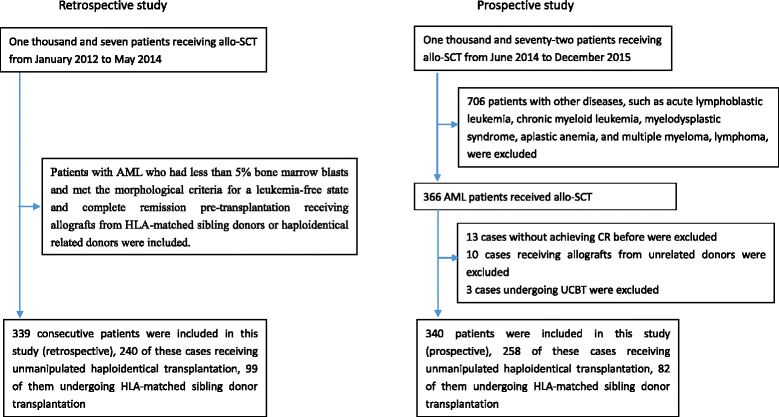Haploidentical allograft is superior to matched sibling donor allograft in eradicating pre-transplantation minimal residual disease of AML patients as determined by multiparameter flow cytometry: a retrospective and prospective analysis
- PMID: 28676064
- PMCID: PMC5496245
- DOI: 10.1186/s13045-017-0502-3
Haploidentical allograft is superior to matched sibling donor allograft in eradicating pre-transplantation minimal residual disease of AML patients as determined by multiparameter flow cytometry: a retrospective and prospective analysis
Abstract
Background: This study compared the effects of pre-transplantation minimal residual disease (pre-MRD) on outcomes in AML patients who underwent human leukocyte antigen-matched sibling donor transplantation (MSDT) or who received unmanipulated haploidentical allografts.
Methods: A retrospective study (n = 339) and a prospective study (n = 340) were performed. MRD was determined using multiparameter flow cytometry.
Results: Either after retrospective or prospective analysis, patients with negative pre-MRD (pre-MRDneg) had a lower incidence of relapse than those with positive pre-MRD (pre-MRDpos) in MSDT settings (P < 0.001 for all), but relapse was comparable in Haplo-SCT settings for patients with pre-MRDneg versus pre-MRDpos (P = 0.866 and 0.161, respectively). In either the retrospective (n = 65) or the prospective study (n = 76), pre-MRDpos subjects receiving Haplo-SCT experienced a lower incidence of relapse than those who underwent MSDT (P < 0.001 and p = 0.017, respectively). Of the patients with pre-MRDpos in either the total (n = 141) or the subgroup excluding cases which received donor lymphocyte infusion (DLI; n = 105), those who underwent MSDT had a higher incidence of relapse than those receiving haplo-SCT (P < 0.01 for all). Multivariate analysis showed that, for pre-MRDpos cases, haplo-SCT was associated with a low incidence of relapse and with better LFS and OS in either retrospective group, prospective group, combination groups, or subgroup not including cases which received DLI.
Conclusions: The results indicated that, for pre-MRD-positive AML patients, haplo-SCT was associated with lower incidence of relapse and better survival, suggesting a stronger anti-leukemia effect.
Keywords: Acute myeloid leukemia; Allogeneic stem cell transplantation; Minimal residual disease; Multiparameter flow cytometry; Unmanipulated haploidentical allografts.
Conflict of interest statement
Ethics approval and consent to participate
All of the included subjects provided written informed consent. The study was conducted in accordance with the Declaration of Helsinki and was approved by the Institutional Review Board of Peking University.
Consent for publication
Not applicable.
Competing interests
The authors declare that they have no competing interests.
Publisher’s Note
Springer Nature remains neutral with regard to jurisdictional claims in published maps and institutional affiliations.
Figures


Similar articles
-
Haploidentical Stem Cell Transplantation for Acute Myeloid Leukemia: Current Therapies, Challenges and Future Prospective.Front Oncol. 2021 Oct 28;11:758512. doi: 10.3389/fonc.2021.758512. eCollection 2021. Front Oncol. 2021. PMID: 34778077 Free PMC article. Review.
-
Impact of pre-transplantation minimal residual disease determined by multiparameter flow cytometry on the outcome of AML patients with FLT3-ITD after allogeneic stem cell transplantation.Ann Hematol. 2018 Jun;97(6):967-975. doi: 10.1007/s00277-018-3265-1. Epub 2018 Feb 8. Ann Hematol. 2018. PMID: 29423758
-
The Quantification of Minimal Residual Disease Pre- and Post-Unmanipulated Haploidentical Allograft by Multiparameter Flow Cytometry in Pediatric Acute Lymphoblastic Leukemia.Cytometry B Clin Cytom. 2020 Jan;98(1):75-87. doi: 10.1002/cyto.b.21840. Epub 2019 Aug 19. Cytometry B Clin Cytom. 2020. PMID: 31424628
-
[A retrospective comparative study of haplotype hematopoietic stem cell transplantation and human leukocyte antigen-matched sibling donor hematopoietic stem cell transplantation in the treatment of acute B-lymphocyte leukemia].Zhonghua Xue Ye Xue Za Zhi. 2022 Mar 14;43(3):221-228. doi: 10.3760/cma.j.issn.0253-2727.2022.03.007. Zhonghua Xue Ye Xue Za Zhi. 2022. PMID: 35405780 Free PMC article. Chinese.
-
Is human leukocyte antigen-matched sibling donor transplant always better than haploidentical allograft?Semin Hematol. 2019 Jul;56(3):201-208. doi: 10.1053/j.seminhematol.2018.07.005. Epub 2018 Aug 23. Semin Hematol. 2019. PMID: 31202431 Review.
Cited by
-
Post-remission measurable residual disease directs treatment choice and improves outcomes for patients with intermediate-risk acute myeloid leukemia in CR1.Int J Hematol. 2022 Dec;116(6):892-901. doi: 10.1007/s12185-022-03441-6. Epub 2022 Aug 28. Int J Hematol. 2022. PMID: 36031670 Free PMC article.
-
Optimized therapeutic strategy for patients with refractory or relapsed acute myeloid leukemia: long-term clinical outcomes and health-related quality of life assessment.Cancer Commun (Lond). 2022 Dec;42(12):1387-1402. doi: 10.1002/cac2.12376. Epub 2022 Oct 23. Cancer Commun (Lond). 2022. PMID: 36274263 Free PMC article.
-
Haploidentical Stem Cell Transplantation for Acute Myeloid Leukemia: Current Therapies, Challenges and Future Prospective.Front Oncol. 2021 Oct 28;11:758512. doi: 10.3389/fonc.2021.758512. eCollection 2021. Front Oncol. 2021. PMID: 34778077 Free PMC article. Review.
-
Allogeneic hematopoietic stem cell transplantation could overcome the poor prognosis of DNMT3AmutNPM1mutFLT3-ITDmut in acute myeloid leukemia: real-world multicenter analysis in China.Front Med. 2025 Feb;19(1):90-100. doi: 10.1007/s11684-024-1091-5. Epub 2024 Dec 7. Front Med. 2025. PMID: 39643798
-
Dose intensity for conditioning in allogeneic hematopoietic cell transplantation: can we recommend "when and for whom" in 2021?Haematologica. 2021 Jul 1;106(7):1794-1804. doi: 10.3324/haematol.2020.268839. Haematologica. 2021. PMID: 33730842 Free PMC article. Review.
References
-
- Walker I, Panzarella T, Couban S, et al. Pretreatment with anti-thymocyte globulin versus no anti-thymocyte globulin in patients with haematological malignancies undergoing haemopoietic cell transplantation from unrelated donors: a randomised, controlled, open-label, phase 3, multicentre trial. Lancet Oncol. 2016;17(2):164–173. doi: 10.1016/S1470-2045(15)00462-3. - DOI - PubMed
Publication types
MeSH terms
Substances
LinkOut - more resources
Full Text Sources
Other Literature Sources
Medical

